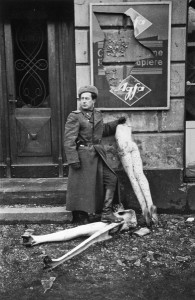Dmitri Baltermants
Agfa, 1945 (Printed at a Later Date)
Gelatin silver print
16 x 20 in.
Scripps College, Gift of Sally Strauss and Andrew E. Tomback
In the majority of Baltermants’ photos, viewers are immersed into the Second World War. Though he was born in Poland, Baltermants served under the Soviets, using his skills as a photojournalist to capture their actions. These photographs function as witnesses to the heat of battle and the calculated destruction of European cities. Here, Baltermants cast his lens on the ruins of Germany during the fall of Berlin in May 1945, focusing on the aftermath of the violence. The tragedy of war is immediately apparent in all of his works, yet it comes through more poignantly in his street photography than it ever could in his most gruesome portraits of conflict. This image presents a Russian soldier standing over the shattered remains of a storefront. Though only a tiny fraction of the building is visible, the extent of its destruction is evident. In Europe, the end of the war was marked by the Allied invasion and Soviet domination of Berlin, which finally brought about the demise of the Third Reich. This final Battle of Berlin, which sealed the fate of the Germans, was primarily motivated by the Soviet’s thirst for revenge. When Hitler turned against Russia at the battle of Stalingrad in 1942, he wreaked havoc on their nation. Now the Soviet army had an opportunity to do the same. The abundant debris that litters the ground, the smashed window, and the burns on the stone walls hint at widespread devastation.
In the face of death and loss the soldier may be incapable of rejoicing in the outcome of the battle. As he stands in the remains of a ravaged city, contemplating the tragedy of the war, there is no pleasure in this final invasion. The only evidence of conquest in this instant is the soldier’s stance over the broken mannequins. He leans possessively atop two pairs of women’s legs. Their form establishes a disturbing analogy and hints at sinister forms of objectification. To a viewer well versed in history, the soldier’s stance clearly alludes to the victor’s treatment of the vanquished.
The title of the piece presumably originates from the slashed poster that occupies the background. A single word printed in a diamond reveals an additional layer of symbolism– “Agfa”. Ironically, Agfa was a photography company that had been absorbed by Berlin in the nineteenth century and represented Germany’s technological prowess at the time. This icon, now in tatters, may convey the fallen state of German power.
Madeline Helland SC ’18
Wilson intern summer 2015


